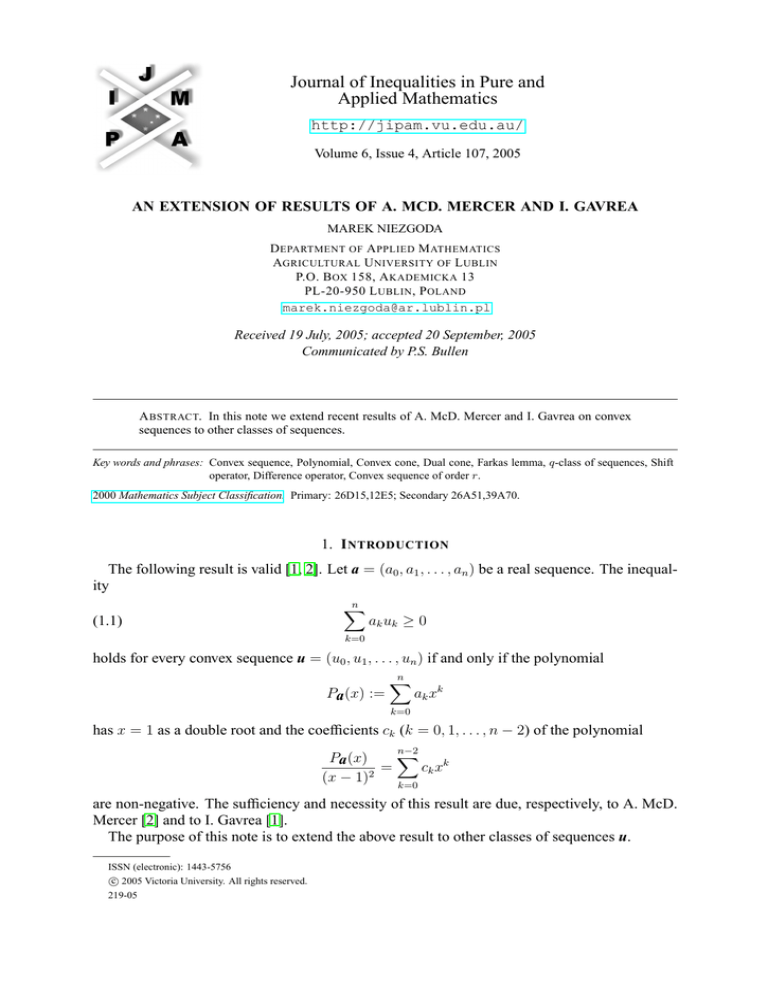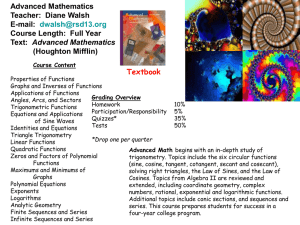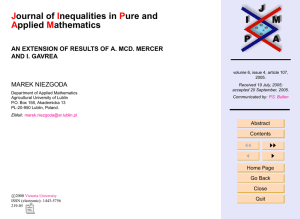
Journal of Inequalities in Pure and
Applied Mathematics
http://jipam.vu.edu.au/
Volume 6, Issue 4, Article 107, 2005
AN EXTENSION OF RESULTS OF A. MCD. MERCER AND I. GAVREA
MAREK NIEZGODA
D EPARTMENT OF A PPLIED M ATHEMATICS
AGRICULTURAL U NIVERSITY OF L UBLIN
P.O. B OX 158, A KADEMICKA 13
PL-20-950 L UBLIN , P OLAND
marek.niezgoda@ar.lublin.pl
Received 19 July, 2005; accepted 20 September, 2005
Communicated by P.S. Bullen
A BSTRACT. In this note we extend recent results of A. McD. Mercer and I. Gavrea on convex
sequences to other classes of sequences.
Key words and phrases: Convex sequence, Polynomial, Convex cone, Dual cone, Farkas lemma, q-class of sequences, Shift
operator, Difference operator, Convex sequence of order r.
2000 Mathematics Subject Classification. Primary: 26D15,12E5; Secondary 26A51,39A70.
1. I NTRODUCTION
The following result is valid [1, 2]. Let a = (a0 , a1 , . . . , an ) be a real sequence. The inequality
(1.1)
n
X
ak u k ≥ 0
k=0
holds for every convex sequence u = (u0 , u1 , . . . , un ) if and only if the polynomial
Pa (x) :=
n
X
ak x k
k=0
has x = 1 as a double root and the coefficients ck (k = 0, 1, . . . , n − 2) of the polynomial
n−2
X
Pa (x)
=
ck xk
(x − 1)2
k=0
are non-negative. The sufficiency and necessity of this result are due, respectively, to A. McD.
Mercer [2] and to I. Gavrea [1].
The purpose of this note is to extend the above result to other classes of sequences u.
ISSN (electronic): 1443-5756
c 2005 Victoria University. All rights reserved.
219-05
2
M AREK N IEZGODA
2. BASIC L EMMA
A convex cone is a non-empty set C ⊂ Rn+1 such that αC + βC ⊂ C for all non-negative
scalars α and β. We say that a convex cone C is generated by a set V ⊂ C, and write C =
cone V , if every vector in C can be expressed as a non-negative linear combination of a finite
number of vectors in V .
Let h·, ·i stand for the standard inner product on Rn+1 . The dual cone of C is the cone defined
by
dual C := {u ∈ Rn+1 : hu, vi ≥ 0 for all v ∈ C}.
It is well-known that
dual dual C = C
(2.1)
for any closed convex cone C ⊂ Rn+1 (cf. [3, Theorem 14.1, p. 121]). The result below
is a key fact in our considerations. It is a consequence of (2.1) for a finitely generated cone
C = cone {v0 , v1 , . . . , vp }.
Lemma 2.1 (Farkas lemma). Let v, v0 , v1 , . . . , vp be vectors in Rn+1 . The following two statements are equivalent:
(i): The inequality hu, vi ≥ 0 holds for all u ∈ Rn+1 such that hu, vi i ≥ 0, i = 0, 1, . . . , p.
(ii): There exist non-negative scalars ci , i = 0, 1, . . . , p, such that
v = c0 v0 + c1 v1 + · · · + cp vp .
3. M AIN R ESULT
Given a sequence q = (q0 , q1 , . . . , qr ) ∈ Rr+1 with 0 ≤ r ≤ n, we define
vi := (0, . . . , 0, q0 , q1 , . . . , qr , 0, . . . , 0) = S i v0 ∈ Rn+1 for i = 0, 1, . . . , n − r.
| {z }
i times
Here S is the shift operator from Rn+1 to Rn+1 defined by
(3.1)
(3.2)
S(z0 , z1 , . . . , zn ) := (0, z0 , z1 , . . . , zn−1 ).
A sequence u = (u0 , u1 , . . . , un ) ∈ Rn+1 is said to be of q-class, if
(3.3)
hu, vi i ≥ 0 for all i = 0, 1, . . . , n − r.
In other words, the q-class consists of all vectors of the cone
(3.4)
D := dual cone {v0 , v1 , . . . , vn−r }.
Example 3.1.
(a). Set r = 0, q0 = 1 and
vi = (0, . . . , 0, 1, 0, . . . , 0) ∈ Rn+1 for i = 0, 1, . . . , n.
| {z }
i times
Then (3.3) reduces to
ui ≥ 0 for i = 0, 1, . . . , n.
Thus D is the class of non-negative sequences.
(b). Put r = 1, q0 = −1 and q1 = 1, and denote
vi = (0, . . . , 0, −1, 1, 0, . . . , 0) ∈ Rn+1 for i = 0, 1, . . . , n − 1.
| {z }
i times
Then (3.3) gives
ui ≤ ui+1 for i = 0, 1, . . . , n − 1,
J. Inequal. Pure and Appl. Math., 6(4) Art. 107, 2005
http://jipam.vu.edu.au/
O N RESULTS OF M ERCER AND G AVREA
3
which means that D is the class of non-decreasing sequences.
(c). Consider r = 2, q0 = 1, q1 = −2, q2 = 1 and
vi = (0, . . . , 0, 1, −2, 1, 0, . . . , 0) ∈ Rn+1 for i = 0, 1, . . . , n − 2.
| {z }
i times
In this case, (3.3) is equivalent to
ui + ui+2
for i = 0, 1, . . . , n − 2.
ui+1 ≤
2
This says that u is a convex sequence. Therefore D is the class of convex sequences.
Theorem 3.1. Let a = (a0 , a1 , . . . , an ) ∈ Rn+1 and q = (q0 , q1 , . . . , qr ) ∈ Rr+1 be given with
0 ≤ r ≤ n. Then the inequality
n
X
(3.5)
ak u k ≥ 0
k=0
holds for every sequence u = (u0 , u1 , . . . , un ) of q-class if and only if the polynomial
Pa (x) :=
n
X
ak x k
k=0
is divisible by the polynomial
Pq (x) :=
r
X
qk x k ,
k=0
and the coefficients ck (k = 0, 1, . . . , n − r) of the polynomial
n−r
Pa (x) X
=
ck xk
Pq (x) k=0
are non-negative.
Proof. The map ϕ that assigns to each sequence b = (b0 , b1 , . . . , bm ) the polynomial
ϕ(b) := Pb (x) :=
m
X
bk x k
k=0
m+1
is a one-to-one linear map from R
to the space of polynomials of degree at most m. Also,
ψ := ϕ−1 is a one-to-one linear map. It is not difficult to check that
ψ(xk Pb (x)) = S k ψ(Pb (x)).
Therefore, for any polynomial
Pc (x) := c0 + c1 x + · · · + cn−r xn−r ,
we have
ψ(Pc (x)Pq (x)) = c0 S 0 v0 + c1 S 1 v0 + · · · + cn−r S n−r v0 = c0 v0 + c1 v1 + · · · + cn−r vn−r ,
where vi are given by (3.1). In other words,
(3.6)
Pc (x)Pq (x) = ϕ(c0 v0 + c1 v1 + · · · + cn−r vn−r ) for any c = (c0 , c1 , . . . , cn−r ).
We are now in a position to show that the following statements are mutually equivalent:
(i): Inequality (3.5) holds for every u of q-class.
(ii): ha, ui ≥ 0 for every u ∈ dual cone {v0 , v1 , . . . , vn−r }.
J. Inequal. Pure and Appl. Math., 6(4) Art. 107, 2005
http://jipam.vu.edu.au/
4
M AREK N IEZGODA
(iii): There exist non-negative scalars c0 , c1 , . . . , cn−r such that a = c0 v0 + c1 v1 + · · · +
cn−r vn−r .
(iv): There exist non-negative scalars c0 , c1 , . . . , cn−r such that Pa (x) = (c0 + c1 x + · · · +
cn−r xn−r )Pq (x).
In fact, (ii) is an easy reformulation of (i) (see (3.4)). That (ii) and (iii) are equivalent is
a direct consequence of Farkas lemma (see Lemma 2.1). We now show the validity of the
implication (iii) ⇒ (iv). By (iii) and (3.6), we have
Pa (x) = ϕ(a) = ϕ(c0 v0 + c1 v1 + · · · + cn−r vn−r ) = Pc (x)Pq (x)
for certain scalars ck ≥ 0, k = 0, 1, . . . , n − r. Thus (iv) is proved.
To prove the implication (iv) ⇒ (iii) assume (iv) holds, that is Pa (x) = Pc (x)Pq (x) with
ck ≥ 0, k = 0, 1, . . . , n − r. Then by (3.6),
a = ψ(Pa (x)) = ψ(Pc (x)Pq (x))
= ψϕ(c0 v0 + c1 v1 + · · · + cn−r vn−r )
= c0 v0 + c1 v1 + · · · + cn−r vn−r .
This completes the proof of Theorem 3.1.
4. A PPLICATIONS FOR C ONVEX S EQUENCES OF O RDER r
In this section we study special types of sequences related to difference calculus and generalized convex sequences.
We introduce the difference operator on sequences z = (z0 , z1 , . . . , zm ) by
∆z := (z1 − z0 , z2 − z1 , . . . , zm − zm−1 ).
Notice that ∆ = ∆m acts from Rm+1 to Rm . We define
∆0 z := z and ∆r z := ∆m−r+1 · · · ∆m−1 ∆m z for r = 1, 2, . . . , m.
A sequence u ∈ Rn+1 is said to be convex of order r (in short, r-convex), if
∆r u ≥ 0.
The last inequality is meant in the componentwise sense in Rn+1−r , that is
h∆r u, ei i ≥ 0 for i = 0, 1, . . . , n − r,
(4.1)
where
ei := (0, . . . , 0, 1, 0, . . . , 0) ∈ Rn+1−r .
| {z }
i times
In order to relate the r-convex sequences to the q-class of Section 3, observe that (4.1)
amounts to
hu, (∆r )T ei i ≥ 0 for i = 0, 1, . . . , n − r,
where (·)T denotes the transpose. By a standard induction argument, we get
(∆r )T ei = S i v0 for i = 0, 1, . . . , n − r,
where S is the shift operator from Rn+1 to Rn+1 given by (3.2), and
(4.2)
v0 := (q, 0, . . . , 0) ∈ R
n+1
r
and q := (q0 , q1 , . . . , qr ) with qj :=
(−1)r−j .
j
As in (3.1), we set
vi := S i v0 for i = 0, 1, . . . , n − r.
J. Inequal. Pure and Appl. Math., 6(4) Art. 107, 2005
http://jipam.vu.edu.au/
O N RESULTS OF M ERCER AND G AVREA
5
In summary, the r-convex sequences form the q-class for q given by (4.2). For example, the
class of r-convex sequences for r = 0 (resp. r = 1, r = 2) is the class of non-negative (resp.
non-decreasing, convex) sequences in Rn+1 (cf. Example 3.1).
By virtue of (4.2) we get
r
X
Pq (x) =
qk xk = (x − 1)r .
k=0
Therefore we obtain from Theorem 3.1
Corollary 4.1. Let a = (a0 , a1 , . . . , an ) ∈ Rn+1 be given with 0 ≤ r ≤ n. Then the inequality
n
X
(4.3)
ak u k ≥ 0
k=0
holds for every r-convex sequence u = (u0 , u1 , . . . , un ) if and only if the polynomial
n
X
Pa (x) =
ak x k
k=0
has x = 1 as a root of multiplicity at least r, and the coefficients ck (k = 0, 1, . . . , n − r) of the
polynomial
n−r
X
Pa (x)
=
ck xk
(x − 1)r
k=0
are non-negative.
Corollary 4.1 extends the mentioned results of A. McD. Mercer and I. Gavrea from r = 2 to
an arbitrary 0 ≤ r ≤ n.
R EFERENCES
[1] I. GAVREA, Some remarks on a paper by A. McD. Mercer, J. Inequal. Pure Appl. Math., 6(1)
(2005), Art. 26. [ONLINE: http://jipam.vu.edu.au/article.php?sid=495]
[2] A. McD. MERCER, Polynomials and convex sequence inequalities, J. Inequal. Pure Appl. Math.,
6(1) (2005), Art. 8. [ONLINE: http://jipam.vu.edu.au/article.php?sid=477]
[3] R.T. ROCKAFELLAR, Convex Analysis, Princeton University Press, Princeton 1970.
J. Inequal. Pure and Appl. Math., 6(4) Art. 107, 2005
http://jipam.vu.edu.au/






